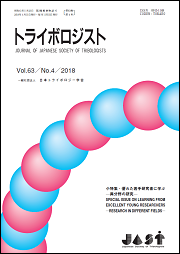69 巻, 3 号
特集・高分子添加剤・薄膜のトライボロジー
選択された号の論文の17件中1~17を表示しています
- |<
- <
- 1
- >
- >|
会告
-
2024 年 69 巻 3 号 p. K3-a
発行日: 2024/03/15
公開日: 2024/03/15
PDF形式でダウンロード (389K) -
2024 年 69 巻 3 号 p. K3-b
発行日: 2024/03/15
公開日: 2024/03/15
PDF形式でダウンロード (1575K)
目次
-
2024 年 69 巻 3 号 p. M3
発行日: 2024/03/15
公開日: 2024/03/15
PDF形式でダウンロード (259K)
連載・トライボロジーを語る
-
2024 年 69 巻 3 号 p. 161
発行日: 2024/03/15
公開日: 2024/03/15
PDF形式でダウンロード (462K)
特集・高分子添加剤・薄膜のトライボロジー
-
2024 年 69 巻 3 号 p. 162
発行日: 2024/03/15
公開日: 2024/03/15
PDF形式でダウンロード (188K)
解説
-
2024 年 69 巻 3 号 p. 163-168
発行日: 2024/03/15
公開日: 2024/03/15
PDF形式でダウンロード (3228K) -
2024 年 69 巻 3 号 p. 169-174
発行日: 2024/03/15
公開日: 2024/03/15
PDF形式でダウンロード (1302K) -
2024 年 69 巻 3 号 p. 175-180
発行日: 2024/03/15
公開日: 2024/03/15
PDF形式でダウンロード (1604K) -
2024 年 69 巻 3 号 p. 181-186
発行日: 2024/03/15
公開日: 2024/03/15
PDF形式でダウンロード (1558K) -
2024 年 69 巻 3 号 p. 187-194
発行日: 2024/03/15
公開日: 2024/03/15
PDF形式でダウンロード (2074K) -
2024 年 69 巻 3 号 p. 195-202
発行日: 2024/03/15
公開日: 2024/03/15
PDF形式でダウンロード (3821K)
トライボロジー・ナウ・トライボエピソード ―博士号取得―
-
2024 年 69 巻 3 号 p. 203-204
発行日: 2024/03/15
公開日: 2024/03/15
PDF形式でダウンロード (4203K) -
2024 年 69 巻 3 号 p. 205-206
発行日: 2024/03/15
公開日: 2024/03/15
PDF形式でダウンロード (2405K)
学術論文
-
2024 年 69 巻 3 号 p. 207-217
発行日: 2024/03/15
公開日: 2024/03/15
[早期公開] 公開日: 2023/09/13PDF形式でダウンロード (3966K)
技術論文
-
2024 年 69 巻 3 号 p. 218-226
発行日: 2024/03/15
公開日: 2024/03/15
[早期公開] 公開日: 2023/11/21PDF形式でダウンロード (5864K)
維持会員のページ
-
2024 年 69 巻 3 号 p. 227
発行日: 2024/03/15
公開日: 2024/03/15
PDF形式でダウンロード (755K)
会のページ
-
2024 年 69 巻 3 号 p. 228-233
発行日: 2024/03/15
公開日: 2024/03/15
PDF形式でダウンロード (1015K)
- |<
- <
- 1
- >
- >|
